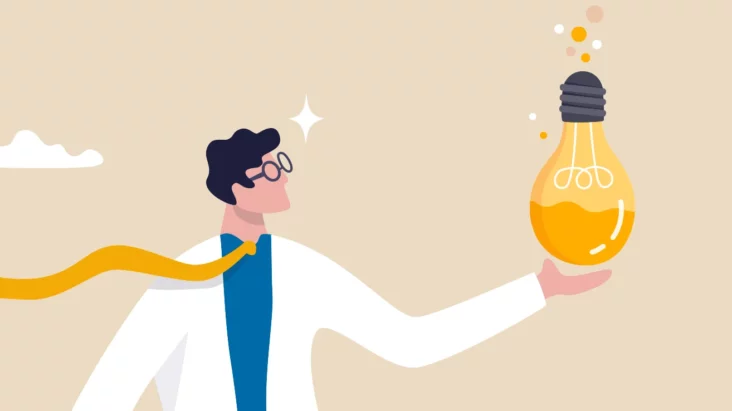In brief:
Design thinking is a process for solving problems by prioritising the consumer’s needs above all else. It relies on observing, with empathy, how people interact with their environments, and employs an iterative, hands-on approach to creating innovative solutions.
Design thinking is a great way to supercharge communication and collaboration within teams. By taking the time to really focus on the user’s needs, it encourages the team to work together in order to create meaningful and successful solutions they can all be proud of. This makes sure that all team members feel valued and heard, helping drive successful product design that customers will love.
What is design thinking? How do you apply it to solve complex problems? Design thinking is a process that relies on empathy and an iterative, hands-on approach to problem solving. It can be used to tackle complex problems that are ill-defined or unknown. In this blog post, we will discuss the five phases of the design thinking process, and how you can use it to create innovative solutions for your business!
What is design thinking?
Design thinking is a really useful and versatile tool that helps you unpack and understand complex problems. It takes an empathetic approach to problem solving, which means considering the user’s experience in order to design optimal solutions. Design thinking is a creative process that goes beyond just creating something; it puts the user’s needs first and requires both research and experimentation to develop quality products or services. The process isn’t linear but instead circles back around on itself, allowing for rapid iteration until the desired outcome is met. Design thinking can be applied in any field of business, from healthcare to marketing, making it a very valuable technique in an ever-changing world.
How can it be used to solve complex problems?
One of the main ways that design thinking can be used to solve complex problems is by employing an iterative process. This means that you will be testing and refining your solutions as you go, which helps to ensure that you are always moving in the right direction. Additionally, design thinking helps you to focus on the user’s needs, which can be essential when trying to solve complex problems. By understanding how people interact with their environment and what they need and want, you can create innovative solutions that meet their needs. Finally, design thinking also employs creative problem solving techniques, which can be helpful when trying to tackle complex issues that are ill-defined or unknown.
Unlock Your Product Potential - Join the Think Product Group Community Today!
AFFILIATE AD
Get ready to join an incredible global network of product enthusiasts! Think Product Group Community is the ultimate platform for aspiring and experienced designers, developers and managers. Here you can take advantage of mentorship, connect with other passionate minds, explore free resources such as how-to videos and templates, and gain hands-on experience through the exclusive ‘Product Pioneers’ program and ‘Product Hack’ live events. Don’t miss out on this amazing opportunity!
The five steps of the design thinking process
The five steps of the design thinking process are empathize, define, ideate, prototype and test. Each of these steps is essential for tackling complex problems. Let’s take a closer look at each one!
1. Empathise
Understand the user and their needs
In the empathize phase, you will be gathering data in order to understand how people interact with their environment. This could involve conducting interviews or going on-site to observe. It’s important to gather as much data as possible in this phase, so that you can get a clear understanding of the problem.
2. Define
Clarify the problem and come up with potential solutions
In the define phase, you will be defining the problem and making sure that everyone is on the same page. This is an important step, as it will help to ensure that everyone is working towards solving the same problem.
3. Ideate
Brainstorm possible solutions
In the ideate phase, you will be brainstorming solutions to the problem. This is where your creativity can really shine, as you will be coming up with all sorts of possible solutions. It’s important to generate as many ideas as possible in this phase, so don’t be afraid to think outside the box!
4. Prototype
Create a mockup of a potential solution
In the prototype phase, you will be creating prototypes of your solutions. This allows you to test out your ideas and see how they work in practice. By testing out different prototypes, you can determine which ones are most effective.
5. Test
Evaluate the prototype and make changes as needed
In the test phase, you will be testing your prototypes with real users. This allows you to get feedback on your solutions and see how well they work in practice. Feedback from users is essential in order to determine if your solution is effective.
What are the benefits of using design thinking?
There are many benefits to using design thinking, including the following:
Out-of-the-box thinking
One great benefit of utilising a design thinking approach is that it promotes out-of-the-box thinking and helps generate unique ideas. This makes it easy to achieve creative innovations that weren’t previously possible, by challenging existing assumptions and introducing elements that may not have been considered previously.
Designing from the user's perspective
Design thinking encourages us to see things from the perspective of the user, allowing us to create products and services that are user-friendly. It helps us make decisions with the customer in mind, such as understanding their needs, motivations, and preferences. Taking a design-centric approach means considering how people will interact with what you build, which helps make better-informed decisions that suit your audience’s wants and needs. By considering the user throughout the entire process, design thinking helps create solutions that not only solve problems but cater to customers for a more enjoyable experience.
Focus on things that work
Design thinking can be a great tool to help generate creative solutions to a wide variety of problems. Another of its standout benefits is the focus it places on finding approaches and solutions that actually work. Rather than wasting time attempting a product or system that may not prove successful, design thinking encourages a testing and refining process in order to find an effective solution. This iterative approach helps reduce wasted money and effort by allowing you to determine quickly whether something is working and adjust your strategy accordingly if needed. Thanks to design thinking’s commitment to practicality, you can trust that the final result will be a thoughtful and effective solution!
Improves communication and collaboration
Design thinking is a great way to supercharge communication and collaboration within teams. It helps to foster an environment of creative problem solving, encouraging different perspectives and expert knowledge. By taking the time to really focus on the user’s needs, it encourages the team to work together in order to create meaningful and successful solutions they can all be proud of. This makes sure that all team members feel valued and heard, helping drive successful product design that customers will love.
Dwayne Campbell
Product Manager | Agile Coach | Business Analyst | Service Designer
With over 15 years of experience in product management, Dwayne is highly skilled in product development and business analysis. He has a proven track record in delivering products and services that include deploying large-scale global e-commerce & web service platforms and developing new citizen-based services that adhere to strict standards around inclusion and accessibility.
Tip on how to apply design thinking in your business
If you’re looking to bring more creativity and innovation into your business, look no further than design thinking. This five-phase process will help you understand your users and their needs, redefine problems and create innovative solutions. By employing an iterative process, you can rapidly refine your solutions and get to the desired outcome more quickly. So why not give design thinking a try? It just might be the key to unlocking new opportunities in your business!
The limitations of design thinking
When it should not be used
While design thinking can be a great way to come up with innovative solutions to problems, it does have its limitations. For one, it can be time-consuming, requiring a lot of effort and resources upfront for little return. It can also be difficult to scale design thinking up or down depending on the size of the problem at hand. Additionally, design thinking may not always be the best approach for complex problems with many unknowns, or when a more analytical or scientific approach is needed.
Some real world examples
How design thinking has been used to solve complex problems
Design thinking has been used to solve complex problems in a variety of industries, including healthcare, education, and business.
Stanford Hospital
One example of how design thinking has been used to solve a complex problem is the redesign of the emergency room at Stanford Hospital. The hospital staff used design thinking to identify the root causes of patient satisfaction issues and to redesign the layout of the emergency room to improve patient flow.
One Laptop per Child program
Another example of how design thinking has been used to solve a complex problem is the development of the One Laptop per Child program. This program was designed to provide affordable, durable laptops to children in developing countries so that they could have access to quality education.
I’ll be exploring these two examples in detail in a future blog post. I think they’re both really interesting and worth delving into!
In conclusion:
Design thinking is a process that helps you to solve problems by prioritising the consumer’s needs above all else. It relies on observing, with empathy, how people interact with their environments and employs an iterative, hands-on approach to creating innovative solutions. By taking the time to really focus on the user’s needs, it encourages teams to work together in order to create meaningful and successful solutions they can all be proud of. This makes sure that all team members feel valued and heard, helping drive successful product design that customers will love. If you’re looking to bring more creativity and innovation into your business, look no further than design thinking!
Reference Sources
- None







